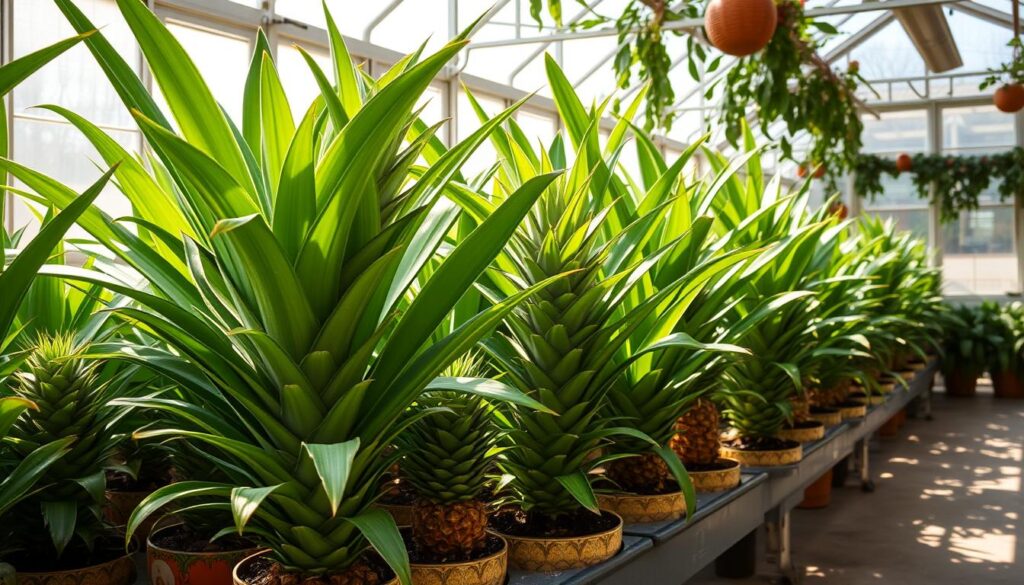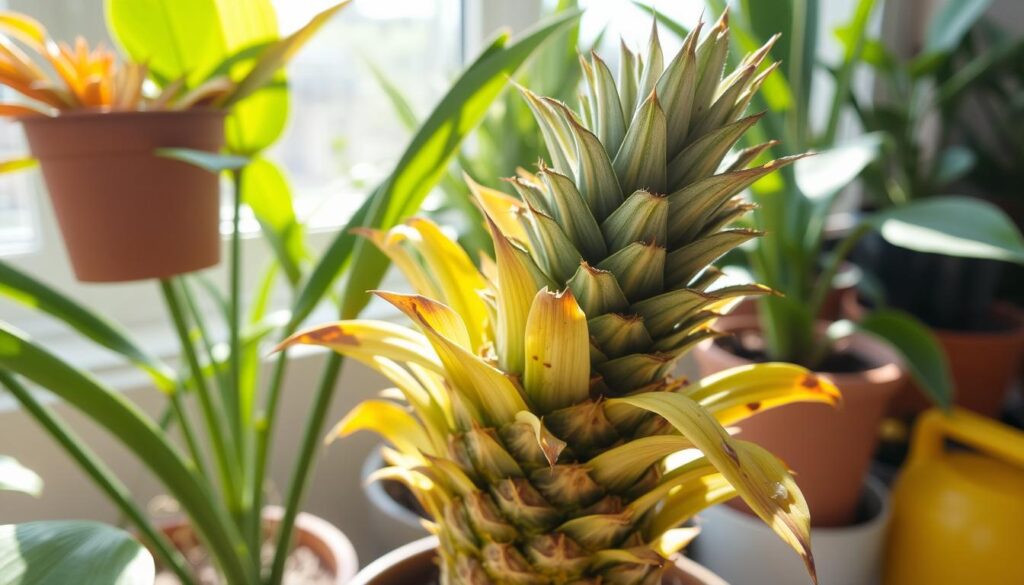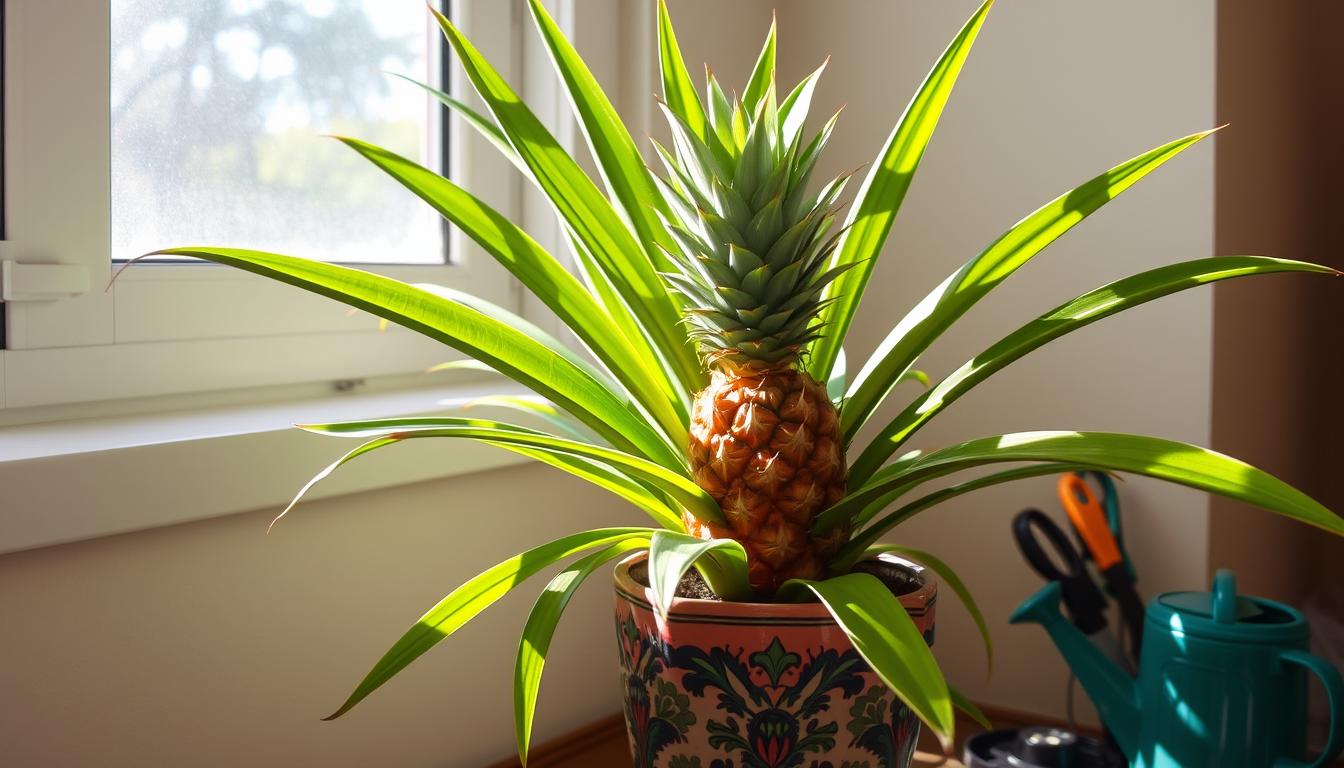Starting your journey in indoor pineapple cultivation is exciting and fulfilling. Growing pineapples indoors lets you care for these tropical fruits in your home. With patience and the right care, you can enjoy a homegrown pineapple in two to three years. Pineapple plants, belonging to the bromeliad family, can grow up to 3 to 4 feet tall.
This guide will walk you through the steps of growing pineapples indoors. We’ll cover choosing the right pineapple crown, rooting, planting, and care. It’s crucial to provide the best conditions, like 6 to 8 hours of sunlight daily and a temperature between 65 and 95 degrees Fahrenheit. As a fan of home gardening and growing fruits at home, I want to share all you need to know for success with tropical plants indoors.
Key Takeaways
- Pineapples can produce mature fruit in approximately two to three years.
- Optimal growing conditions include 6 to 8 hours of direct sunlight daily.
- A 5-gallon pot is suitable for growing pineapple indoors.
- Pineapple plants thrive in temperatures ranging from 65°F to 95°F.
- It typically takes 1 to 3 months for a pineapple crown to root.
Introduction to Indoor Pineapple Cultivation
Many gardeners are drawn to growing pineapples indoors. It adds a lively touch to any room and connects us to nature. With the right care, pineapples can turn any space into a tropical paradise.
Pineapples were once seen as symbols of wealth. Now, they’re easy to grow at home. They need lots of light, warmth, and care to thrive. It takes about two years for them to start producing fruit, which requires patience and dedication.
Growing tropical fruits like pineapples brings many benefits. They not only give us tasty fruit but also improve the air and look of our homes. By giving them plenty of sunlight, we can create the perfect environment for them.
Starting an indoor pineapple garden is a rewarding experience. It teaches us to appreciate nature and enjoy the fruits of our labor. Growing pineapples at home is a unique way to connect with the natural world.
The Benefits of Growing Pineapples at Home
Growing pineapples at home is rewarding and enriches my living space. They are easy to care for, making tropical gardening simple. The joy of growing a plant is unmatched.
Setting up the right conditions for my pineapple is a fun challenge. It teaches me and brings personal growth. In about 15 months, I get to enjoy the fruit of my labor, turning my home into a tropical paradise.
Harvesting ripe pineapples is a special moment. It’s a taste experience that beats store-bought. It makes mealtime more exciting with a burst of flavor.
Also, growing pineapples means I control what pesticides are used. This leads to healthier eating. Each plant can grow new suckers, allowing for endless gardening adventures. Sharing my journey with others introduces them to the joys of growing pineapples at home.
| Benefit | Description |
|---|---|
| Low Maintenance | Pineapples require minimal care, allowing me to enjoy gardening without heavy commitment. |
| Flavor | Homegrown pineapples provide a fresher and sweeter taste compared to store-bought varieties. |
| Learning Experience | Nurturing a plant offers valuable lessons in growth, care, and patience. |
| Control Over Chemicals | I can manage pesticide use, promoting healthier eating and reducing chemical exposure. |
| Propagation | Pineapples can produce side shoots, allowing for future gardening projects and increased yields. |
Choosing the Right Pineapple Variety
Choosing the right pineapple variety is key to growing them indoors. Knowing the options helps me grow tasty fruits at home.
Popular Varieties for Indoor Growth
Many tropical pineapple varieties grow well indoors. The Smooth Cayenne pineapple is a top pick for home gardeners. Here’s why:
- Its spineless leaves make picking easy and safe.
- The low-fiber flesh tastes sweet and juicy.
- It has a lot of sugar, making it great for eating fresh or juicing.
Other great options for indoor growth include:
- Queen Victoria: Sweet and perfect for small spaces.
- Sugarloaf: Offers a unique taste with lots of sugar.
- Red: Its color is stunning, and it tastes amazing, great for decoration.
Understanding the Smooth Cayenne Cultivar
The Smooth Cayenne pineapple is a top choice for indoor gardening. It grows well in containers and needs special care:
- Use a pot of at least 10 inches or 3 gallons for good root growth.
- It needs free-draining soil and a balanced fertilizer with an NPK ratio of 10-10-10.
- Give it at least 5 hours of direct sunlight a day or use artificial grow lights for better growth.
Choosing the right variety is very important. It lets me grow healthy plants and enjoy fresh pineapple at home. For more gardening tips, check out Garden Beginner.
How to Grow Pineapples Indoors
To start growing pineapples indoors, find a healthy pineapple crown at a store. Look for one with firm, green leaves and golden-brown fruit skin. This ensures a strong start for your plant.
Next, prepare the crown. Trim and strip the leaves, then let it dry for a couple of days. This step helps prevent rot and supports growth.
Lighting is key. Your pineapple needs at least six to eight hours of sunlight a day. If sunlight is scarce, use grow lights that mimic direct sun. Keep the temperature between 65°F and 95°F to mimic the tropical home of pineapple plants.
Water your pineapple once a week in the first year. This avoids harming the roots. Roots will grow strong in six to eight weeks. After a year, repot it in a twelve-inch clay pot with cactus mix to prevent wet feet.
As your plant matures, it will start producing fruit from Year 2. This is a great reward for your care. With the right conditions, your pineapple will grow and produce more fruit.
| Step | Description | Timeline |
|---|---|---|
| Sourcing the Crown | Select a healthy pineapple crown with firm leaves | Immediate |
| Drying the Crown | Allow the trimmed crown to dry for healing | 2-3 days |
| Planting | Plant crown in a suitable pot with well-draining soil | Immediate |
| Root Development | Roots typically establish within | 6–8 weeks |
| Repotting | Move to a larger pot after 1 year | After 1 year |
| Harvesting | Fruits can begin to form | From Year 2 |
Preparing the Pineapple Crown for Planting
To grow a pineapple indoors, start with the right crown preparation. Choose a fruit that’s healthy and ready for planting. A good pineapple has green leaves and a golden-brown skin. These signs mean it’s mature and ready to grow.
Selecting a Healthy Pineapple
When picking a pineapple, look for certain signs of health. I check for:
- Vibrant green leaves at the top, which show it’s alive.
- A golden-brown skin that means it’s ripe.
- A sweet smell, which tells me it’s ready for planting.
These traits help me pick the best pineapple for planting.
Proper Crown Preparation Techniques
After picking the right pineapple, I prepare the crown. Here’s what I do:
- I carefully cut off the leafy top with a sharp knife.
- I remove extra fruit flesh to show the stem. This stops it from rotting.
- I let the crown dry for a few days. This helps it root better.
These steps help my pineapple grow well indoors. They’re key to a successful pineapple plant.
Rooting Your Pineapple Crown
Rooting my pineapple crown is key for a successful indoor pineapple project. I can try different methods to get it right. Planting the crown in soil helps it grow strong roots. Or, I can put the crown in water to watch the roots grow.
With the water method, I change the water often. It’s important to keep the crown in a stable, not too hot or cold, place. It usually takes a month or two for the roots to grow well. I keep an eye on the crown for signs of growth.
To root a pineapple crown, I cut it about half an inch below the leaves and remove some lower leaves. Letting the cut top dry for a few days helps prevent rot. By following these steps, I can enjoy growing my own pineapples indoors.
Planting the Pineapple Crown
Planting pineapple crowns needs the right mix and pot size. These things help your pineapple plant grow well.
Choosing the Right Potting Mix
Choosing the right potting mix is key for pineapple plants. I use a mix of cactus soil, perlite, or sand. This mix helps water drain well, preventing root rot.
It’s important to keep the soil moist but not too wet. Pineapples can handle some drought.
Optimal Pot Size for Pineapples
The pot size for pineapples changes as they grow. Start with a 6- to 8-inch pot for new crowns. As they grow, they’ll need bigger pots.
Eventually, a 5-gallon container is best for their roots. Make sure the pots have good drainage for healthy growth.
Providing the Right Growing Conditions
Creating the perfect environment is key for my pineapple plants to grow well. It’s important to know their needs for sunlight, temperature, and humidity. This knowledge helps me get the best results.
Light Requirements for Tropical Growth
Pineapples need bright, indirect light for six to eight hours a day. This light helps them feel like they’re in their natural home. I place my plants by a south-facing window for the best light.
If it’s too dark, I use grow lights. These lights give five or more hours of direct sunlight. I aim for a light level of 15+ mol/m²/day for strong growth.
Temperature and Humidity Considerations
The right temperature is crucial, between 60°F and 90°F. This warmth helps my pineapple grow and produce well. Keeping the temperature steady is important.
Also, I make sure the humidity is right for tropical plants. I mist the leaves or use a humidifier in dry places. This helps my pineapple feel at home.

To learn more about growing pineapples indoors, I check out tips for indoor pineapple care. I make sure my methods match the best practices for tropical plants.
Pineapple Care: Watering and Fertilization
Caring for a pineapple plant means knowing its needs, especially for watering and fertilizing. The right balance ensures the plant grows well and stays healthy. Following best practices helps the plant thrive and produce better fruit.
Best Practices for Watering Pineapples
Pineapples like their soil to dry a bit before watering again. I wait until the top inch of soil is dry before watering. This prevents root rot from too much water.
It’s important to have a pot with holes for water to drain. This stops water from pooling. When I water, I soak the soil deeply. This lets the roots drink well.
Choosing the Right Fertilizer
I choose a balanced organic fertilizer for my pineapple. It has nitrogen, phosphorus, and potassium. A monthly dose during growing season helps it grow strong.
I use a 10-10-10 formula. It’s great for growth and fruit. I spread it around the base of the plant to feed the roots.
For more tips or questions, check my contact page. Talking with other gardeners can be very helpful.
| Watering Techniques | Notes |
|---|---|
| Frequency | Allow top inch to dry before watering |
| Depth of Watering | Deep soak to ensure root absorption |
| Drainage | Use pots with drainage holes to prevent water accumulation |
| Fertilization for Fruit Growth | Recommended Product |
|---|---|
| Type | Balanced organic fertilizer |
| NPK Ratio | 10-10-10 recommended |
| Application Frequency | Monthly during growing season |
Encouraging Blooms and Fruit Development
Getting pineapple blooms can be tricky, especially after months of care. The first step is to create the right conditions for flowers. I use ethylene gas, like placing overripe apples near my plants, to help.
Once blooms appear, patience is key. It can take 5 to 7 months for fruit to grow. This depends on the pineapple type and the environment. Keeping temperatures around 80ºF and humidity between 40% and 60% is important. Also, my plants need 6-8 hours of direct sunlight each day.
I focus on pineapple flowering tips and nutrient management. I use a balanced 10-10-5 plant food in spring and summer. Before flowers, I adjust the fertilizer to boost potassium for fruit growth. This helps my blooms and fruit quality.
During blooming, I watch the moisture levels to avoid root rot. Success in getting blooms comes from careful observation and creating the best conditions for my plants.
| Key Factors | Optimal Conditions |
|---|---|
| Temperature | 80ºF (65-95ºF range) |
| Humidity | 40%-60% |
| Light | 6-8 hours of direct sunlight |
| Fertilization | 10-10-5 plant food during spring/summer |
| Watering Frequency | More frequent in spring and summer |
Transplanting and Repotting Your Pineapple Plant
Transplanting pineapple plants is key for their growth and health. It’s needed when they outgrow their pots. I watch for signs of root growth like roots poking out or slow growth. These signs help me keep my plant thriving.
Signs Your Pineapple Needs to be Repotted
There are clear signs that your pineapple plant needs a new home:
- Roots visibly protruding from drainage holes
- Stunted growth or yellowing leaves
- Drooping leaves despite proper care
- Soil disintegration, showing nutrient loss
- Signs of distress that don’t go away
How to Repot Without Damage
Using safe transplanting techniques is crucial. I pick a pot that’s 2 inches wider than the old one for more room. I mix sandy soil, compost, and vermiculite for the new soil. This mix helps with drainage and keeps nutrients.
I gently remove the plant from its old pot, being careful with the roots. Then, I put it in the new pot and fill it with soil, making sure it’s snug but not too tight. After repotting, I give it lots of sunlight, at least six hours a day. I keep it warm, between 65°F to 75°F. I also watch the moisture and adjust my watering to help it settle in.
Pineapple Plant Troubleshooting
Even the most dedicated indoor pineapple gardeners can face challenges. Recognizing and addressing common pineapple plant problems is key. This helps promote healthy growth and fruitful results. Pineapple plants may show signs of distress for many reasons, which I can often fix with a few adjustments.
Identifying and Addressing Common Issues
Common pineapple plant problems include yellowing leaves, stunted growth, or wilting. These issues often come from overwatering or not enough sunlight. Pineapples need at least 5+ hours of direct sun daily. Less sun can cause stress.
Improving drainage helps with root rot. Moving the plant for better light can also help. Regularly checking for these symptoms is crucial for my pineapple’s health.
Pest Management Strategies for Indoor Plants
Insect pests can harm my pineapple plants. Pests like mealybugs can cause stress and decline. I check my plants often to catch pests early.
Using neem oil or insecticidal soap can manage infestations. These treatments are safe for the plant. Knowing when and how to use them is important for my pineapple’s health.

Conclusion
Growing pineapples indoors is a rewarding journey. It turns my home into a lively tropical paradise. To succeed, I must meet my pineapple’s needs, like keeping the soil slightly acidic and well-draining.
Being patient and careful is key as my pineapple grows. It goes through stages from growing leaves to producing fruit. By following the steps in this guide, I’ll get to enjoy my homegrown pineapples.
With the right approach and techniques, I can enjoy the sweet taste of my pineapples. For more tips on growing fruits indoors, I can check out this detailed guide. It’s a great resource for my pineapple gardening journey.



Leave a Reply